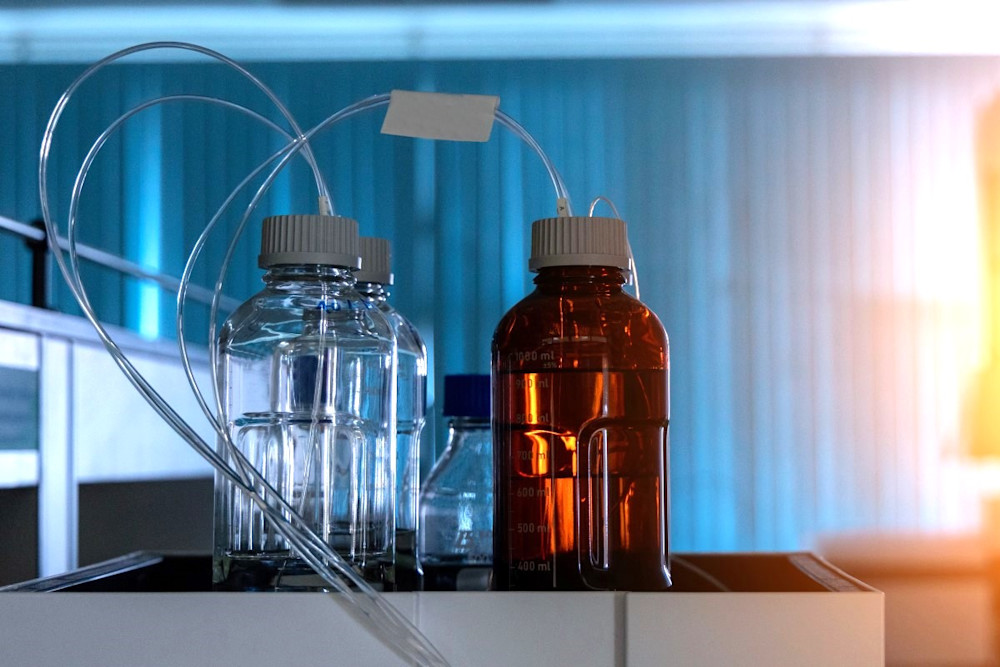HPLC-MS analysis
HPLC-MS is an effective analytical technique for determining the composition and purity of chemicals. The combination of high-performance liquid chromatography (HPLC) and mass spectrometry (MS) offers great capabilities in physical separation and mass analysis, providing accurate data on sample composition.

Some of our HPLC services
Specific migration testing – Irganox 1076
Bisphenol A content
Substances of very high concern (SVHC) analysis
Aflatoxin B1, B2, G1, and G2 determination
Carotenoid analysis package
Dietary supplement contaminant analysis package (extended)
Specific migration testing – N,N-Bis(2-hydroxyethyl)alkyl(C8-C18)amine
Pesticide residue screening (extensive package)
Prices excluding VAT (24 %).
- Fast turnaround times
- Personal service from method experts
- Competitive prices
- Result accuracy guarantee
HPLC mass spectrometry as an analytical tool
High-performance liquid chromatography-mass spectrometry (HPLC-MS) is an ideal tool for the identification, quantitation, and mass analysis of components, often used to determine the chemical composition and purity of chemicals. HPLC-MS has high sensitivity and is optimal for performing precise and reproducible quantitative analyses. The method is ideal for detecting heat-labile compounds, such as proteins and vitamins in food products. Food contaminants are also often quantified using HPLC-MS.
The operating principle
In HPLC-MS, the two techniques (HPLC and MS) are connected by an interface that transfers the separated components from the liquid chromatograph column into the mass spectrometer ion source. An interface is needed since HPLC operates at high pressure and the MS system has a high vacuum.
HPLC includes a mobile phase and a stationary phase, both of which can be modified to suit the sample matrix and the desired properties to be determined. Usually, the mobile phase is adjusted to suit the sample, and the stationary phase is adjusted to work well with the mobile phase. The degree of compound separation is based on the compound’s affinity for the mobile phase.
HPLC methods can be divided into two main categories based on the properties of the stationary and mobile phases. A combination of a polar stationary phase and a non-polar mobile phase is called "normal-phase chromatography" and the opposite of that, the combination of a non-polar stationery and a polar mobile phase is called "reverse-phase chromatography".
Normal-phase HPLC
In normal-phase HPLC, the column is usually filled with silica particles. The silica is polar and will bind to polar molecules in the mobile phase. This means that the least polar compounds elute first and the most polar compounds last. Normal-phase HPLC is suitable for highly hydrophobic or hydrophilic compounds, compounds that are not soluble in water, and compounds that may decompose in water. The ideal use of normal-phase HPLC is the separation of isomers.
Reverse-phase HPLC
In reverse-phase HPLC, the stationary phase usually consists of C8 or C18 silica (silica derivatized with alkyl chains). Unlike in normal-phase HPLC, in reverse-phase HPLC, the most polar compounds elute first and the least polar compounds last. The stationary phase can be composed of different solids to meet different needs.
Combining HPLC with mass spectrometry
Once compounds have been separated using HPLC, they are identified and their contents are determined by mass spectrometry (MS), which creates a mass spectrum that is unique for every compound. In mass spectrometry, the compounds and their fragments are ionized using either electron or chemical ionization. The sample is then accelerated through a mass analyzer, which includes either a quadrupole or an ion trap, and the ions are identified based on their mass-to-charge (m/z) ratios.
It is also possible to combine HPLC with detectors other than the mass spectrometer. In HPLC-DAD analysis, for example, a diode-array detector is used instead. The choice of the most appropriate detector depends on the analyte and the goal of the analysis. In general, HPLC-MS is more suitable for identifying unknown components, while the DAD-detector works well in quantifying known components.
Samples and sample preparation
HPLC-MS is suitable for samples in liquid form. For solid sample matrices, sample preparation is necessary. Compounds that are being determined must be extracted into a solvent and filtered before analysis.
Suitable sample matrices
- Pharmaceutical products
- Cosmetics
- Environmental samples
- Biological samples
- Packaging materials
- Chemical products
- Food products
Ideal uses of HPLC-MS
- Quality assurance and quality control
- Quantitative purity analysis
- Proteomics analysis
- Pharmaceutical analysis
- Non-volatile and complex molecule analysis
- Isomer separation and identification
Ask for an offer
Fill in the form, and we'll reply in one business day.
Have questions or need help? Email us at info@measurlabs.com or call +358 50 336 6128.
Frequently asked questions
High-performance liquid chromatography-mass spectrometry is commonly used for analyzing organic and inorganic compounds. Contaminant screening, including POP testing, is a popular application. Complex samples, often found in the environment, are especially well-suited for HPLC-MS.
Compounds analyzed with HPLC-MS need to be soluble in common solvents like water, different types of alcohol, or acetonitrile. The instruments usually have limited pump pressure and are often not compatible with aggressive non-polar solvents. UHPLC-MS offers a higher pressure setup and thus improves the sensitivity.
Samples must be in liquid form, which means that solid samples must be extracted into a solvent and filtered.
Measurlabs offers a variety of laboratory analyses for product developers and quality managers. We perform some of the analyses in our own lab, but mostly we outsource them to carefully selected partner laboratories. This way we can send each sample to the lab that is best suited for the purpose, and offer high-quality analyses with more than a thousand different methods to our clients.
When you contact us through our contact form or by email, one of our specialists will take ownership of your case and answer your query. You get an offer with all the necessary details about the analysis, and can send your samples to the indicated address. We will then take care of sending your samples to the correct laboratories and write a clear report on the results for you.
Samples are usually delivered to our laboratory via courier. Contact us for further details before sending samples.